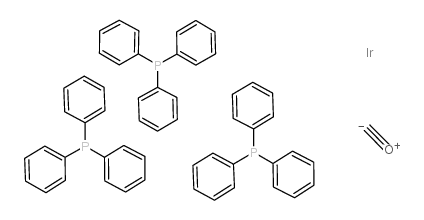Carbonylhydridotris(triphenylphosphine)iridium(I)
Modify Date: 2024-01-14 07:56:56

Carbonylhydridotris(triphenylphosphine)iridium(I) structure
|
Common Name | Carbonylhydridotris(triphenylphosphine)iridium(I) | ||
|---|---|---|---|---|
| CAS Number | 17250-25-8 | Molecular Weight | 1007.08000 | |
| Density | N/A | Boiling Point | 360ºC at 760mmHg | |
| Molecular Formula | C55H45IrOP3 | Melting Point | 170ºC (dec.) | |
| MSDS | N/A | Flash Point | 181.7ºC | |
| Name | Carbonylhydridotris(triphenylphosphine)iridium(I) |
|---|---|
| Synonym | More Synonyms |
| Boiling Point | 360ºC at 760mmHg |
|---|---|
| Melting Point | 170ºC (dec.) |
| Molecular Formula | C55H45IrOP3 |
| Molecular Weight | 1007.08000 |
| Flash Point | 181.7ºC |
| Exact Mass | 1007.23000 |
| PSA | 40.77000 |
| LogP | 10.12640 |
| Vapour Pressure | 4.74E-05mmHg at 25°C |
|
Section 1: Product Identification Chemical Name:Hydridocarbonyltris(triphenylphosphine)iridium (I), 99% CAS Registry Number:17250-25-8 Formula:IrH(CO)[(C6H5)3P]3 EINECS Number:none Chemical Family:metal carbonyl complexes Synonym:none
Section 2: Composition and Information on Ingredients IngredientCAS NumberPercentACGIH (TWA)OSHA (PEL) Title Compound17250-25-8100%no datano data Section 3: Hazards Identification Emergency Overview:Irritating to skin, eyes and respiratory tract. Primary Routes of Exposure:Ingestion, inhalation, skin, eyes Eye Contact:Causes slight or mild irritation of the eyes. Skin Contact:Causes slight to mild irritation of the skin. Inhalation:Irritating to the nose, mucous membranes and respiratory tract. Ingestion:No information on the physiological effects of ingestion. Acute Health Affects:Irritating to skin, eyes and respiratory tract. Chronic Health Affects:No information available on long-term chronic effects. NTP:No IARC:No OSHA:No SECTION 4: First Aid Measures Immediately flush the eyes with copious amounts of water for at least 10-15 minutes. A victim may need Eye Exposure: assistance in keeping their eye lids open. Get immediate medical attention. Wash the affected area with water. Remove contaminated clothes if necessary. Seek medical assistance if Skin Exposure: irritation persists. Remove the victim to fresh air. Closely monitor the victim for signs of respiratory problems, such as difficulty Inhalation: in breathing, coughing, wheezing, or pain. In such cases seek immediate medical assistance. Seek medical attention immediately. Keep the victim calm. Give the victim water (only if conscious). Induce Ingestion: vomiting only if directed by medical personnel. SECTION 5: Fire Fighting Measures Flash Point:not applicable Autoignition Temperature:none Explosion Limits:none Extinguishing Medium:carbon dioxide, foam or dry powder If this product is involved in a fire, fire fighters should be equipped with a NIOSH approved positive pressure Special Fire Fighting Procedures: self-contained breathing apparatus and full protective clothing. Hazardous Combustion andIf involved in a fire this material may emit irritating fumes. Decomposion Products: Unusual Fire or Explosion Hazards: No unusual fire or explosion hazards. SECTION 6: Accidental Release Measures Spill and Leak Procedures:Small spills can be mixed with vermiculite or sodium carbonate and swept up. SECTION 7: Handling and Storage Handling and Storage:Store in a tightly sealed container. Keep away from heat and direct sunlight. SECTION 8: Exposure Controls and Personal Protection Eye Protection:Always wear approved safety glasses when handling a chemical substance in the laboratory. Skin Protection:Wear protective clothing and gloves. Ventilation:If possible, handle the material in an efficient fume hood. If ventilation is not available, a respirator should be worn. The use of respirators requires a Respiratory Respirator: Protection Program to be in compliance with 29 CFR 1910.134. Ventilation:If possible, handle the material in an efficient fume hood. Additional Protection:No additional protection required. SECTION 9: Physical and Chemical Properties Color and Form:light yellow pwdr. Molecular Weight:1008.12 Melting Point:170° dec. Boiling Point:no data Vapor Pressure:no data Specific Gravity:no data Odor:none Solubility in Water:insoluble SECTION 10: Stability and Reactivity Stability:air sensitive Hazardous Polymerization:no hazardous polymerization Conditions to Avoid:prolonged contact with air. Incompatibility:oxidizing agents Decomposition Products:carbon dioxide, carbon monoxide, organic fumes, phosphorous pentoxide, and iridium compounds. SECTION 11: Toxicological Information RTECS Data:No information available in the RTECS files. Carcinogenic Effects:No data available Mutagenic Effects:No data available Tetratogenic Effects:No data available SECTION 12: Ecological Information Ecological Information:No information available SECTION 13: Disposal Considerations Disposal:Dispose of according to local, state and federal regulations. SECTION 14: Transportation Shipping Name (CFR):Non-hazardous Hazard Class (CFR):NA Additional Hazard Class (CFR):NA Packaging Group (CFR):NA UN ID Number (CFR):NA Shipping Name (IATA):Non-hazardous Hazard Class (IATA):NA Additional Hazard Class (IATA):NA Packaging Group (IATA):NA UN ID Number (IATA):NA SECTION 15: Regulatory Information TSCA:Listed in the TSCA inventory. SARA (Title 313):Title compound not listed. Second Ingredient:none SECTION 16 - ADDITIONAL INFORMATION N/A |
| Hazard Codes | Xn |
|---|---|
| Risk Phrases | R36/37/38 |
| Safety Phrases | 26-36/37/39 |
| RIDADR | UN2813 |
| Packaging Group | III |
| Hazard Class | 4.3 |
| HYDRIDOCARBONYLTRIS(TRIPHENYLPHOSPHINE)IRIDIUM (I) |
| Hydridocarbonyltris(triphenylphosphine)iridium(I) |
| Carbonyltris(triphenylphosphine)iridium(I) hydride |
| Tris(triphenylphosphine)iridium(I) Carbonyl Hydride |
| EINECS 241-282-7 |
| MFCD00015525 |

